肢体语言中英文
- 格式:ppt
- 大小:1.46 MB
- 文档页数:61
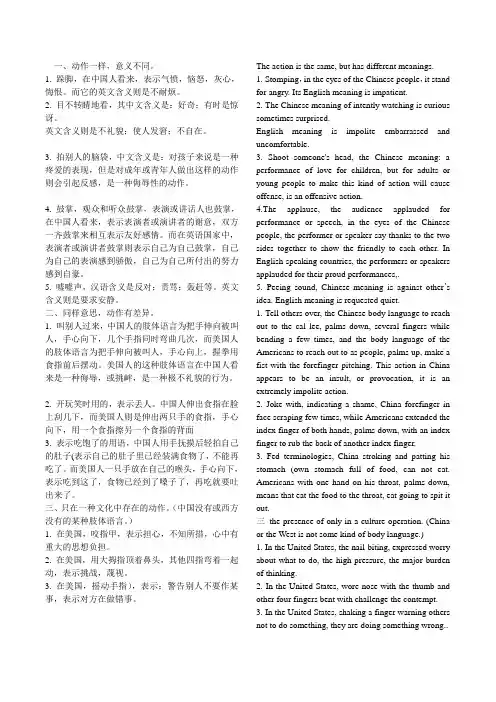
一、动作一样,意义不同。
1. 跺脚,在中国人看来,表示气愤,恼怒,灰心,悔恨。
而它的英文含义则是不耐烦。
2. 目不转睛地看,其中文含义是:好奇;有时是惊讶。
英文含义则是不礼貌;使人发窘;不自在。
3. 拍别人的脑袋,中文含义是:对孩子来说是一种疼爱的表现,但是对成年或青年人做出这样的动作则会引起反感,是一种侮辱性的动作。
4. 鼓掌,观众和听众鼓掌,表演或讲话人也鼓掌,在中国人看来,表示表演者或演讲者的谢意,双方一齐鼓掌来相互表示友好感情。
而在英语国家中,表演者或演讲者鼓掌则表示自己为自己鼓掌,自己为自己的表演感到骄傲,自己为自己所付出的努力感到自豪。
5. 嘘嘘声,汉语含义是反对;责骂;轰赶等。
英文含义则是要求安静。
二、同样意思,动作有差异。
1. 叫别人过来,中国人的肢体语言为把手伸向被叫人,手心向下,几个手指同时弯曲几次,而美国人的肢体语言为把手伸向被叫人,手心向上,握拳用食指前后摆动。
美国人的这种肢体语言在中国人看来是一种侮辱,或挑衅,是一种极不礼貌的行为。
2. 开玩笑时用的,表示丢人。
中国人伸出食指在脸上刮几下,而美国人则是伸出两只手的食指,手心向下,用一个食指擦另一个食指的背面3. 表示吃饱了的用语,中国人用手抚摸后轻拍自己的肚子(表示自己的肚子里已经装满食物了,不能再吃了。
而美国人一只手放在自己的喉头,手心向下,表示吃到这了,食物已经到了嗓子了,再吃就要吐出来了。
三、只在一种文化中存在的动作。
(中国没有或西方没有的某种肢体语言。
)1. 在美国,咬指甲,表示担心,不知所措,心中有重大的思想负担。
2. 在美国,用大拇指顶着鼻头,其他四指弯着一起动,表示挑战,蔑视。
3. 在美国,摇动手指),表示:警告别人不要作某事,表示对方在做错事。
The action is the same, but has different meanings. 1. Stomping,in the eyes of the Chinese people,it stand for angry. Its English meaning is impatient.2. The Chinese meaning of intently watching is curious sometimes surprised.English meaning is impolite embarrassed and uncomfortable.3. Shoot someone's head, the Chinese meaning: a performance of love for children, but for adults or young people to make this kind of action will cause offense, is an offensive action.4.The applause, the audience applauded for performance or speech, in the eyes of the Chinese people, the performer or speaker say thanks to the two sides together to show the friendly to each other. In English-speaking countries, the performers or speakers applauded for their proud performances,.5. Peeing sound, Chinese meaning is against other’s idea. English meaning is requested quiet.1. Tell others over, the Chinese body language to reach out to the cal lee, palms down, several fingers while bending a few times, and the body language of the Americans to reach out to as people, palms up, make a fist with the forefinger pitching. This action in China appears to be an insult, or provocation, it is an extremely impolite action.2. Joke with, indicating a shame, China forefinger in face scraping few times, while Americans extended the index finger of both hands, palms down, with an index finger to rub the back of another index finger.3. Fed terminologies, China stroking and patting his stomach (own stomach full of food, can not eat. Americans with one hand on his throat, palms down, means that eat the food to the throat, eat going to spit it out.三the presence of only in a culture operation. (China or the West is not some kind of body language.)1. In the United States, the nail-biting, expressed worry about what to do, the high pressure, the major burden of thinking.2. In the United States, wore nose with the thumb and other four fingers bent with challenge the contempt.3. In the United States, shaking a finger warning others not to do something, they are doing something wrong..4. 在美国,把胳膊放在胸前,握紧拳头,拇指向下,向下摆几次,表示反对某人;表示强烈反对。
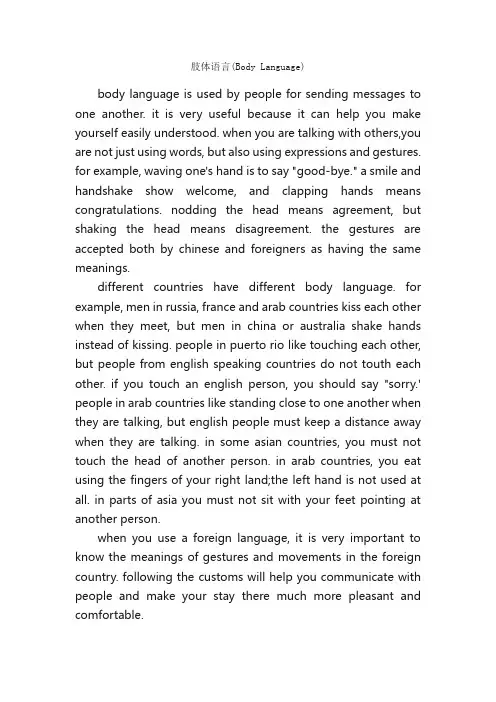
肢体语言(Body Language)body language is used by people for sending messages to one another. it is very useful because it can help you make yourself easily understood. when you are talking with others,you are not just using words, but also using expressions and gestures. for example, waving one's hand is to say "good-bye." a smile and handshake show welcome, and clapping hands means congratulations. nodding the head means agreement, but shaking the head means disagreement. the gestures are accepted both by chinese and foreigners as having the same meanings.different countries have different body language. for example, men in russia, france and arab countries kiss each other when they meet, but men in china or australia shake hands instead of kissing. people in puerto rio like touching each other, but people from english speaking countries do not touth each other. if you touch an english person, you should say "sorry.' people in arab countries like standing close to one another when they are talking, but english people must keep a distance away when they are talking. in some asian countries, you must not touch the head of another person. in arab countries, you eat using the fingers of your right land;the left hand is not used at all. in parts of asia you must not sit with your feet pointing at another person.when you use a foreign language, it is very important to know the meanings of gestures and movements in the foreign country. following the customs will help you communicate with people and make your stay there much more pleasant and comfortable.。
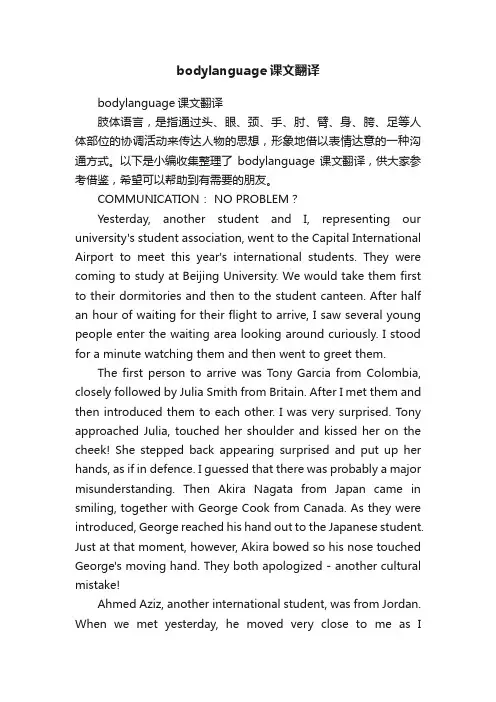
bodylanguage课文翻译bodylanguage课文翻译肢体语言,是指通过头、眼、颈、手、肘、臂、身、胯、足等人体部位的协调活动来传达人物的思想,形象地借以表情达意的一种沟通方式。
以下是小编收集整理了bodylanguage课文翻译,供大家参考借鉴,希望可以帮助到有需要的朋友。
COMMUNICATION: NO PROBLEM?Yesterday, another student and I, representing our university's student association, went to the Capital International Airport to meet this year's international students. They were coming to study at Beijing University. We would take them first to their dormitories and then to the student canteen. After half an hour of waiting for their flight to arrive, I saw several young people enter the waiting area looking around curiously. I stood for a minute watching them and then went to greet them.The first person to arrive was Tony Garcia from Colombia, closely followed by Julia Smith from Britain. After I met them and then introduced them to each other. I was very surprised. Tony approached Julia, touched her shoulder and kissed her on the cheek! She stepped back appearing surprised and put up her hands, as if in defence. I guessed that there was probably a major misunderstanding. Then Akira Nagata from Japan came in smiling, together with George Cook from Canada. As they were introduced, George reached his hand out to the Japanese student. Just at that moment, however, Akira bowed so his nose touched George's moving hand. They both apologized - another cultural mistake!Ahmed Aziz, another international student, was from Jordan. When we met yesterday, he moved very close to me as Iintroduced myself. I moved back a bit, but he came closer to ask a question and then shook my hand. When Darlene Coulon from France came dashing through the door, she recognized Tony Garcia's smiling face. They shook hands and then kissed each other twice on each cheek, since that is the French custom when adults meet people they know. Ahmed Aziz, on the contrary, simply nodded at the girls. Men from Middle Eastern and other Muslim countries will often stand quite close to other men to talk but will usually not touch women.As I get to know more international friends, I learn more about this cultural "body language". Not all cultures greet each other the same way, nor are they comfortable in the same way with touching or distance between people. In the same way that people communicate with spoken language, they also express their feelings using unspoken "language" through physical distance, actions or posture. English people, for example, do not usually stand very close to others or touch strangers as soon as they meet. However, people from places like Spain, Italy or South American countries approach others closely and are more likely to touch them. Mostpeople around the world now greet each other by shaking hands, but some cultures use other greetings as well, such as the Japanese, who prefer to bow.These actions are not good or bad, but are simply ways in which cultures have developed. I have seen, however, that cultural customs for body language are very general - not all members of a culture behave in the same way. In general, though, studying international customs can certainly help avoid difficulties in today's world of cultural crossroads!交际:没有问题了吗?昨天,我和另一个学生代表我们学校的学生会,到首都国际机场迎接今年的留学生。
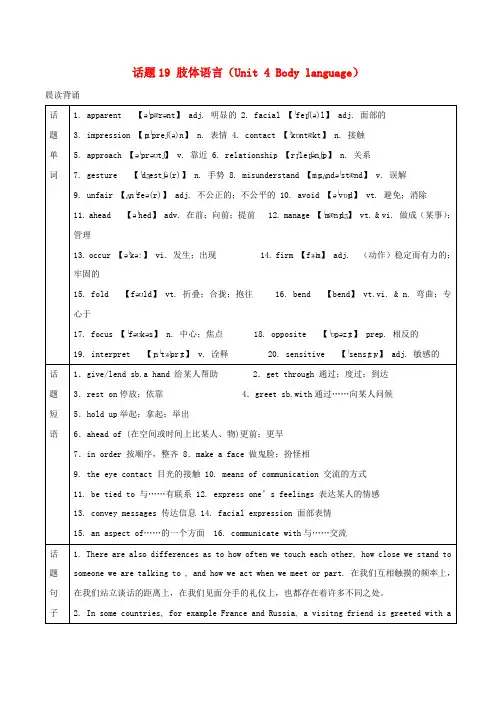
话题19 肢体语言(Unit 4 Body language)晨读背诵kiss o n the cheek. 有些国家,如法国和俄罗斯,人们在来访的朋友的脸颊上亲吻表示欢迎。
3. We can learn a lot about what a person is thinking by watching his or her body language. 我们能够通过一个人的身体的动作了解他的许多所思所想。
4.And if we are feeling down or lonely,there is nothing better than to see the smiling face of a good friend. 如果我们情绪低落或感到孤独,那么没有比看到好友的笑脸更好的了。
5.While there are many different interpretations of our body language,some gestures seem to be universal.尽管对于身势语的解释五花八门,但某些手势语似乎是全球通用的。
6.What are some situations where we need to be very careful about our body language and gestures?在什么样的场合我们需要注意我们的身势语和姿势呢?7. But we found that the first impression begins with a handshake that set the tone for the rest of the interview. 但是我们发现第一印象是以握手开始的,并为面试的余下部分定下基调。
篇章模板When we communicate with other people it is not only our words that contain the meaning. An important part of that meaning comes from what is called “non-verbal (非言辞的) communication”. By this we mean facial expression, gestures with hands, arms, legs, the way we sit or stand, the way we touch other people, the distance we keep between ourselves and the people we are talking to, our dress and our appearance. All these say something to other people.汉语大意:当我们与其他人交流的时候,我们的语言并不是唯一包含意思的。

一、动作一样,意义不同。
1. 跺脚,在中国人看来,表示气愤,恼怒,灰心,悔恨。
而它的英文含义则是不耐烦。
2. 目不转睛地看,其中文含义是:好奇;有时是惊讶。
英文含义则是不礼貌;使人发窘;不自在。
3. 拍别人的脑袋,中文含义是:对孩子来说是一种疼爱的表现,但是对成年或青年人做出这样的动作则会引起反感,是一种侮辱性的动作。
4. 鼓掌,观众和听众鼓掌,表演或讲话人也鼓掌,在中国人看来,表示表演者或演讲者的谢意,双方一齐鼓掌来相互表示友好感情。
而在英语国家中,表演者或演讲者鼓掌则表示自己为自己鼓掌,自己为自己的表演感到骄傲,自己为自己所付出的努力感到自豪。
5. 嘘嘘声,汉语含义是反对;责骂;轰赶等。
英文含义则是要求安静。
二、同样意思,动作有差异。
1. 叫别人过来,中国人的肢体语言为把手伸向被叫人,手心向下,几个手指同时弯曲几次,而美国人的肢体语言为把手伸向被叫人,手心向上,握拳用食指前后摆动。
美国人的这种肢体语言在中国人看来是一种侮辱,或挑衅,是一种极不礼貌的行为。
2. 开玩笑时用的,表示丢人。
中国人伸出食指在脸上刮几下,而美国人则是伸出两只手的食指,手心向下,用一个食指擦另一个食指的背面3. 表示吃饱了的用语,中国人用手抚摸后轻拍自己的肚子(表示自己的肚子里已经装满食物了,不能再吃了。
而美国人一只手放在自己的喉头,手心向下,表示吃到这了,食物已经到了嗓子了,再吃就要吐出来了。
三、只在一种文化中存在的动作。
(中国没有或西方没有的某种肢体语言。
)1. 在美国,咬指甲,表示担心,不知所措,心中有重大的思想负担。
2. 在美国,用大拇指顶着鼻头,其他四指弯着一起动,表示挑战,蔑视。
3. 在美国,摇动手指),表示:警告别人不要作某事,表示对方在做错事。
The action is the same, but has different meanings. 1. Stomping,in the eyes of the Chinese people,it stand for angry. Its English meaning is impatient.2. The Chinese meaning of intently watching is curious sometimes surprised.English meaning is impolite embarrassed and uncomfortable.3. Shoot someone's head, the Chinese meaning: a performance of love for children, but for adults or young people to make this kind of action will cause offense, is an offensive action.4.The applause, the audience applauded for performance or speech, in the eyes of the Chinese people, the performer or speaker say thanks to the two sides together to show the friendly to each other. In English-speaking countries, the performers or speakers applauded for their proud performances,.5. Peeing sound, Chinese meaning is against other’s idea. English meaning is requested quiet.1. Tell others over, the Chinese body language to reach out to the cal lee, palms down, several fingers while bending a few times, and the body language of the Americans to reach out to as people, palms up, make a fist with the forefinger pitching. This action in China appears to be an insult, or provocation, it is an extremely impolite action.2. Joke with, indicating a shame, China forefinger in face scraping few times, while Americans extended the index finger of both hands, palms down, with an index finger to rub the back of another index finger.3. Fed terminologies, China stroking and patting his stomach (own stomach full of food, can not eat. Americans with one hand on his throat, palms down, means that eat the food to the throat, eat going to spit it out.三the presence of only in a culture operation. (China or the West is not some kind of body language.)1. In the United States, the nail-biting, expressed worry about what to do, the high pressure, the major burden of thinking.2. In the United States, wore nose with the thumb and other four fingers bent with challenge the contempt.3. In the United States, shaking a finger warning others not to do something, they are doing something wrong..4. 在美国,把胳膊放在胸前,握紧拳头,拇指向下,向下摆几次,表示反对某人;表示强烈反对。
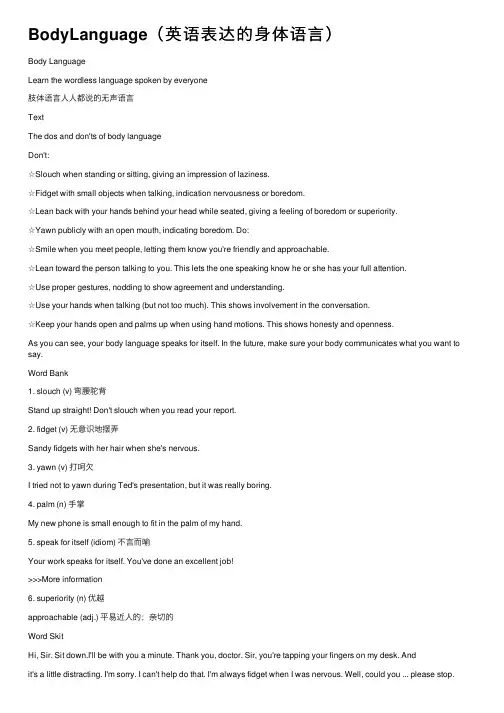
BodyLanguage(英语表达的⾝体语⾔)Body LanguageLearn the wordless language spoken by everyone肢体语⾔⼈⼈都说的⽆声语⾔TextThe dos and don'ts of body languageDon't:☆Slouch when standing or sitting, giving an impression of laziness.☆Fidget with small objects when talking, indication nervousness or boredom.☆Lean back with your hands behind your head while seated, giving a feeling of boredom or superiority.☆Yawn publicly with an open mouth, indicating boredom. Do:☆Smile when you meet people, letting them know you're friendly and approachable.☆Lean toward the person talking to you. This lets the one speaking know he or she has your full attention.☆Use proper gestures, nodding to show agreement and understanding.☆Use your hands when talking (but not too much). This shows involvement in the conversation.☆Keep your hands open and palms up when using hand motions. This shows honesty and openness.As you can see, your body language speaks for itself. In the future, make sure your body communicates what you want to say.Word Bank1. slouch (v) 弯腰驼背Stand up straight! Don't slouch when you read your report.2. fidget (v) ⽆意识地摆弄Sandy fidgets with her hair when she's nervous.3. yawn (v) 打呵⽋I tried not to yawn during Ted's presentation, but it was really boring.4. palm (n) ⼿掌My new phone is small enough to fit in the palm of my hand.5. speak for itself (idiom) 不⾔⽽喻Your work speaks for itself. You've done an excellent job!>>>More information6. superiority (n) 优越approachable (adj.) 平易近⼈的;亲切的Word SkitHi, Sir. Sit down.I'll be with you a minute. Thank you, doctor. Sir, you're tapping your fingers on my desk. Andit's a little distracting. I'm sorry. I can't help do that. I'm always fidget when I was nervous. Well, could you ... please stop.Thank you. I'll be with you a minute. Sir,you're fidgeting again. You're fidgeting with your car keys. Oh? Was I fidgeting again? Yes. I always do that when I'm nervous. I just move my body. I like to fidget. Could you please stop? I'll just take those for seconds. So what can I do for you, sir? Doctor, I really need your help. How can I help you? I really can't stop fidgeting. Stop ... No ... Don't fidgeting!Usage TipChat roomdos and don'ts 该为和不为ins and outs 所有细节ups and downs 酸甜苦辣Language Tip1. fidget [v.] 坐⽴不安The children were fidgeting in their seats during class. fidget with something 因⽆聊⽽⽆意识地把玩东西。
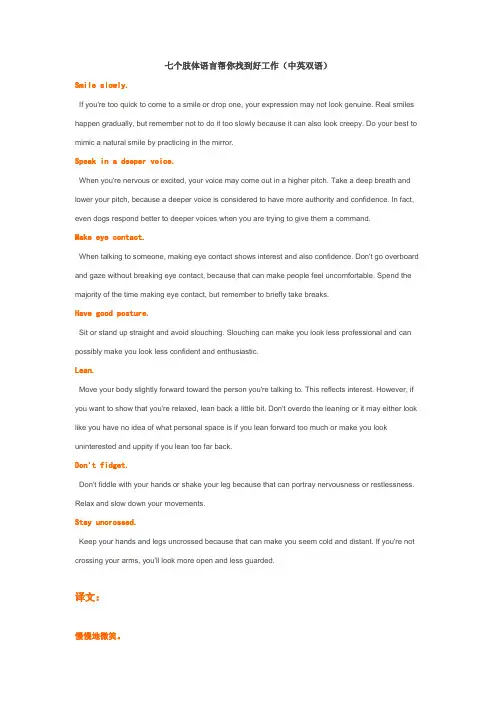
七个肢体语言帮你找到好工作(中英双语)Smile slowly.If you're too quick to come to a smile or drop one, your expression may not look genuine. Real smiles happen gradually, but remember not to do it too slowly because it can also look creepy. Do your best to mimic a natural smile by practicing in the mirror.Speak in a deeper voice.When you're nervous or excited, your voice may come out in a higher pitch. Take a deep breath and lower your pitch, because a deeper voice is considered to have more authority and confidence. In fact, even dogs respond better to deeper voices when you are trying to give them a command.Make eye contact.When talking to someone, making eye contact shows interest and also confidence. Don't go overboard and gaze without breaking eye contact, because that can make people feel uncomfortable. Spend the majority of the time making eye contact, but remember to briefly take breaks.Have good posture.Sit or stand up straight and avoid slouching. Slouching can make you look less professional and can possibly make you look less confident and enthusiastic.Lean.Move your body slightly forward toward the person you're talking to. This reflects interest. However, if you want to show that you're relaxed, lean back a little bit. Don't overdo the leaning or it may either look like you have no idea of what personal space is if you lean forward too much or make you look uninterested and uppity if you lean too far back.Don't fidget.Don't fiddle with your hands or shake your leg because that can portray nervousness or restlessness. Relax and slow down your movements.Stay uncrossed.Keep your hands and legs uncrossed because that can make you seem cold and distant. If you're not crossing your arms, you'll look more open and less guarded.译文:慢慢地微笑。
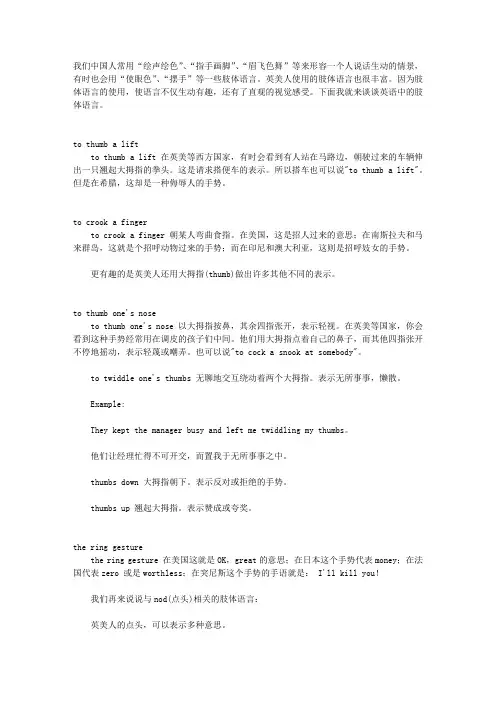
我们中国人常用“绘声绘色”、“指手画脚”、“眉飞色舞”等来形容一个人说话生动的情景,有时也会用“使眼色”、“摆手”等一些肢体语言。
英美人使用的肢体语言也很丰富。
因为肢体语言的使用,使语言不仅生动有趣,还有了直观的视觉感受。
下面我就来谈谈英语中的肢体语言。
to thumb a liftto thumb a lift 在英美等西方国家,有时会看到有人站在马路边,朝驶过来的车辆伸出一只翘起大拇指的拳头。
这是请求搭便车的表示。
所以搭车也可以说"to thumb a lift"。
但是在希腊,这却是一种侮辱人的手势。
to crook a fingerto crook a finger 朝某人弯曲食指。
在美国,这是招人过来的意思;在南斯拉夫和马来群岛,这就是个招呼动物过来的手势;而在印尼和澳大利亚,这则是招呼妓女的手势。
更有趣的是英美人还用大拇指(thumb)做出许多其他不同的表示。
to thumb one's noseto thumb one's nose 以大拇指按鼻,其余四指张开,表示轻视。
在英美等国家,你会看到这种手势经常用在调皮的孩子们中间。
他们用大拇指点着自己的鼻子,而其他四指张开不停地摇动,表示轻蔑或嘲弄。
也可以说"to cock a snook at somebody"。
to twiddle one's thumbs 无聊地交互绕动着两个大拇指。
表示无所事事,懒散。
Example:They kept the manager busy and left me twiddling my thumbs。
他们让经理忙得不可开交,而置我于无所事事之中。
thumbs down 大拇指朝下。
表示反对或拒绝的手势。
thumbs up 翘起大拇指。
表示赞成或夸奖。
the ring gesturethe ring gesture 在美国这就是OK,great的意思;在日本这个手势代表money;在法国代表zero 或是worthless;在突尼斯这个手势的手语就是: I'll kill you!我们再来说说与nod(点头)相关的肢体语言:英美人的点头,可以表示多种意思。
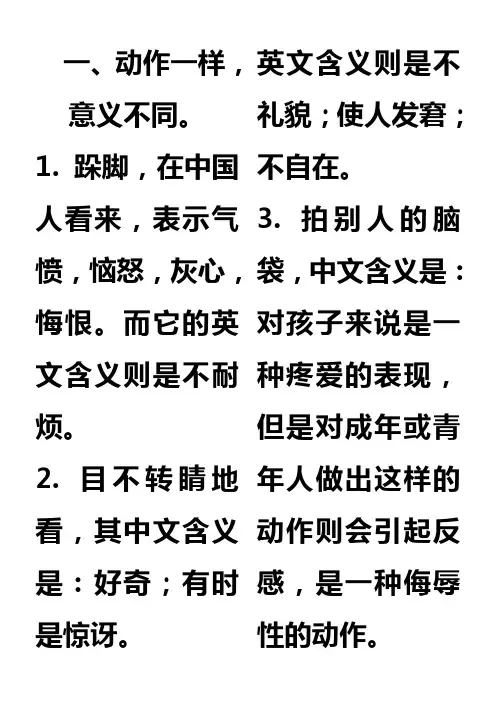
一、动作一样,意义不同。
1. 跺脚,在中国人看来,表示气愤,恼怒,灰心,悔恨。
而它的英文含义则是不耐烦。
2. 目不转睛地看,其中文含义是:好奇;有时是惊讶。
英文含义则是不礼貌;使人发窘;不自在。
3. 拍别人的脑袋,中文含义是:对孩子来说是一种疼爱的表现,但是对成年或青年人做出这样的动作则会引起反感,是一种侮辱性的动作。
4. 鼓掌,观众和听众鼓掌,表演或讲话人也鼓掌,在中国人看来,表示表演者或演讲者的谢意,双方一齐鼓掌来相互表示友好感情。
而在英语国家中,表演者或演讲者鼓掌则表示自己为自己鼓掌,自己为自己的表演感到骄傲,自己为自己所付出的努力感到自豪。
5. 嘘嘘声,汉语含义是反对;责骂;轰赶等。
英文含义则是要求安静。
二、同样意思,动作有差异。
1. 叫别人过来,中国人的肢体语言为把手伸向被叫人,手心向下,几个手指同时弯曲几次,而美国人的肢体语言为把手伸向被叫人,手心向上,握拳用食指前后摆动。
美国人的这种肢体语言在中国人看来是一种侮辱,或挑衅,是一种极不礼貌的行为。
2. 开玩笑时用的,表示丢人。
中国人伸出食指在脸上刮几下,而美国人则是伸出两只手的食指,手心向下,用一个食指擦另一个食指的背面3. 表示吃饱了的用语,中国人用手抚摸后轻拍自己的肚子(表示自己的肚子里已经装满食物了,不能再吃了。
而美国人一只手放在自己的喉头,手心向下,表示吃到这了,食物已经到了嗓子了,再吃就要吐出来了。
三、只在一种文化中存在的动作。
(中国没有或西方没有的某种肢体语言。
)1. 在美国,咬指甲,表示担心,不知所措,心中有重大的思想负担。
2. 在美国,用大拇指顶着鼻头,其他四指弯着一起动,表示挑战,蔑视。
3. 在美国,摇动手指),表示:警告别人不要作某事,表示对方在做错事。
The action is the same, but has different meanings. 1. Stomping,in the eyes of the Chinese people,it stand for angry. Its English meaning is impatient.2. The Chinese meaning of intently watching is curious sometimes surprised. English meaning is impolite embarrassed and uncomfortable.3. Shoot someone's head, the Chinese meaning: a performance of love for children, but for adults or young peopleto make this kind of action will cause offense, is an offensive action.4.The applause, the audience applauded for performance or speech, in the eyes of the Chinese people, the performer or speaker say thanks to the two sides together to show the friendly to each other. In English-speaking countries, the performers or speakers applauded for their proud performances, .5. Peeing sound, Chinese meaning is against other’s idea. English meaning is requested quiet.1. Tell others over, the Chinese body language to reach out to the cal lee,palms down, several fingers while bending a few times, and the body language of the Americans to reach out to as people, palms up, make a fist with the forefinger pitching. This action in China appears to be an insult, or provocation, it is an extremely impolite action.2. Joke with, indicating ashame, China forefinger in face scraping few times, while Americans extended the index finger of both hands, palms down, with an index finger to rub the back of another index finger.3. Fed terminologies, China stroking and patting his stomach (own stomach full of food, can not eat. Americanswith one hand on his throat, palms down, means that eat the food to the throat, eat going to spit it out.三the presence of only in a culture operation. (China or the West is not some kind of body language.)1. In the United States, the nail-biting, expressed worry about what to do,the high pressure, the major burden of thinking. 2. In the United States, wore nose with the thumb and other four fingers bent with challenge the contempt.3. In the United States, shaking a finger warning others not to do something, they are doing something wrong..4. 在美国,把胳膊放在胸前,握紧拳头,拇指向下,向下摆几次,表示反对某人;表示强烈反对。
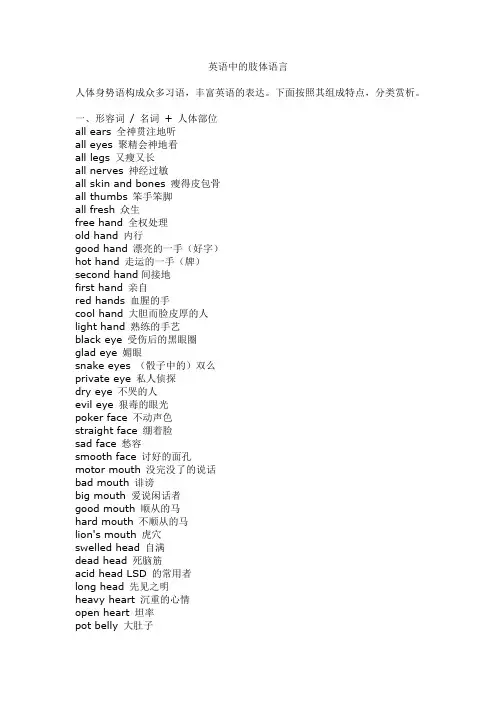
英语中的肢体语言人体身势语构成众多习语,丰富英语的表达。
下面按照其组成特点,分类赏析。
一、形容词/ 名词+ 人体部位all ears 全神贯注地听all eyes 聚精会神地看all legs 又瘦又长all nerves 神经过敏all skin and bones 瘦得皮包骨all thumbs 笨手笨脚all fresh 众生free hand 全权处理old hand 内行good hand 漂亮的一手(好字)hot hand 走运的一手(牌)second hand间接地first hand 亲自red hands 血腥的手cool hand 大胆而脸皮厚的人light hand 熟练的手艺black eye 受伤后的黑眼圈glad eye 媚眼snake eyes (骰子中的)双么private eye 私人侦探dry eye 不哭的人evil eye 狠毒的眼光poker face 不动声色straight face 绷着脸sad face 愁容smooth face 讨好的面孔motor mouth 没完没了的说话bad mouth 诽谤big mouth 爱说闲话者good mouth 顺从的马hard mouth 不顺从的马lion's mouth 虎穴swelled head 自满dead head 死脑筋acid head LSD 的常用者long head 先见之明heavy heart 沉重的心情open heart 坦率pot belly 大肚子stiff neck 顽固之人silver tongue 流利的口才mailed fist 暴力devil's bones 骰子loose lips 说话很随便cold shoulder 冷漠cold feet 胆怯green thumb 在园艺方面有才能的人Achilles heel 弱点busy body 管闲事者sweet tooth 爱吃甜食之人family skeleton 家丑二、人体部位+ 名词brain drain 人才外流brain trust 智囊团brain storm 突有灵感brain child 头脑的产物brain wave 计上心头tongue twister 绕口令face card 带人像的扑克牌face value 票面价值knee slipper 使人笑得拍大腿的笑话eye shot 视野bone shaker 老爷车skin dive 只戴眼罩的潜水skin game 赌博骗钱skull session 坐在一起动脑筋nose dive 一落千丈elbow grease 可施展之地chin music 聊天leg work 跑腿lip praise 表面的称赞lip service 空口的应酬话blood debt 血债belly laugh 捧腹大笑skin flick 色情电影三、动词+ 人体部位keep / save face 保全面子preserve face 保持面子maintain face 维护面子lose face 失去面子make faces 做鬼脸make mouths 对人做嘴脸make eyes 漫送秋波make head 前进count heads 点名knock head 叩头gather head 时机成熟change hands 易手join hands 携手联合kiss hands 吻君王之手hold hands 手搀手change foot 换步set foot 行走play footsie 情侣在桌底下碰脚rub elbow / shoulders 与人交往lose heart 沮丧take heart 鼓起勇气gain flesh 长肉lose flesh 消瘦tell noses 清点人数split hairs 作琐细的分析cut teeth 长牙give lip 讲硬话show leg 逃跑give / throw tongue 猫/狗狂吠shake hands 握手四、人体部位对称或并列face to face 面对面from ear to ear 开心limb to limb 肢解mouth to mouth 嘴对嘴heart to heart 交心shoulder to shoulder 齐头并进eye to eye 赞同eyeball to eyeball 面对面hand to hand 逼近head to head 交头接耳nose to nose 面对面back to back 背靠背hand in hand 手拉手arm in arm 挽臂neck and neck 并驾齐驱leg and leg 平分秋色side by side 肩并肩hand over hand 两手交叉使用from hand to hand 用手传递from mouth to mouth 口口相传from hand to mouth 勉强糊口from head to foot 全身from top to toe 从头到脚hand and foot 手脚一起;尽力heart and soul 全心全意tooth and nail 竭尽全力toe and heel 跳舞flesh and blood 人类head and ears 全身hand to fish 齐心协力hand over fist 多而快地赚钱hand over heels 倒栽葱tooth for tooth 以牙还牙eye for eye 以眼还眼五、人体部位在谚语的运用Two heads are better than one . 三个臭皮匠,胜似一个诸葛亮。
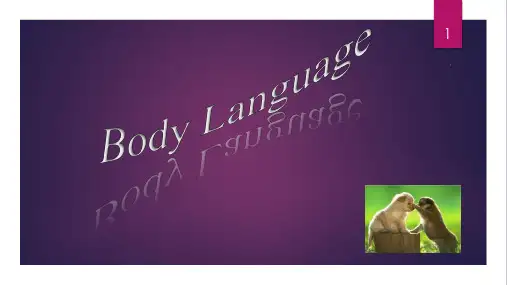
肢体语言英文作文1. When someone crosses their arms, it usually means they are feeling defensive or closed off. It's a way of creating a physical barrier between themselves and others.It can also indicate that they are feeling cold or uncomfortable.2. Leaning forward can show that someone is engaged and interested in what you are saying. It's a way of showingthat they are actively listening and paying attention. Onthe other hand, leaning back can indicate that someone is relaxed or disinterested.3. Eye contact is a powerful form of nonverbal communication. When someone maintains eye contact with you, it shows that they are interested in what you are sayingand that they respect you. Avoiding eye contact, on theother hand, can indicate shyness, discomfort, or dishonesty.4. Fidgeting or playing with objects can be a sign ofnervousness or anxiety. It's a way for someone to release excess energy or distract themselves from a stressful situation. It can also indicate boredom or impatience.5. Smiling is a universal sign of happiness and friendliness. When someone smiles at you, it can instantly create a positive and welcoming atmosphere. However, it's important to note that not all smiles are genuine. A forced or fake smile can be easily detected through the eyes and lack of facial muscle movement.6. Gesturing with hands can add emphasis and clarity to verbal communication. It can help to illustrate a point or convey emotions. However, excessive or erratic hand gestures can be distracting and may indicate nervousness or lack of control.7. Posture can reveal a lot about a person's confidence and self-esteem. Standing or sitting up straight with shoulders back and head held high can project an image of strength and authority. Slouching or hunching over, on the other hand, can indicate insecurity or low self-confidence.8. Touching or physical contact can vary greatly depending on cultural norms and personal boundaries. In some cultures, it is common to greet with a hug or a kiss on the cheek, while in others, it may be considered inappropriate. When in doubt, it's best to err on the side of caution and wait for the other person to initiate physical contact.9. Mirroring is a subconscious behavior where people mimic each other's body language and gestures. It is often a sign of rapport and connection. When someone mirrors your actions, it can indicate that they are comfortable and in sync with you.10. Overall, paying attention to someone's body language can provide valuable insights into their thoughts and feelings. It's important to remember that body language is not always accurate and can be influenced by various factors such as cultural differences, personal habits, and individual preferences. Therefore, it's essential toconsider multiple cues and context when interpreting nonverbal communication.。
必修四unit4bodylanguage课文翻译第一篇:必修四unit 4 body language课文翻译沟通:没问题吗?昨天,我和另一个学生代表我们大学的学生会去首都国际机场迎接今年的国际学生。
他们是来北京大学学习的。
我们会先带他们去宿舍,然后去学生餐厅。
等了半个小时后,他们的航班到了,我看见几个年轻人进入等候区,好奇地环顾四周。
观察了他们一分钟后, 我便过去和他们打招呼。
第一个到达的是来自哥伦比亚的托尼·加西亚。
紧接着是来自英国的朱丽.亚史密斯。
在与他们碰面并介绍他们彼此认识后,我(对看到的情景)感到很吃惊。
托尼走近朱莉娅,摸了摸她的肩膀,并亲吻了她的脸颊!她后退了几步,看上去有些吃惊,她举起双手,仿佛在自卫。
我猜想这里可能有个大的误会。
然后日本的永田明笑着走了进来,同时来的还有来自加拿大的乔治.库克。
我为他们作了介绍后,乔治把手伸向了这位日本学生。
然而,就在那时田永明鞠了一躬,所以他的鼻子碰到了乔治伸过来的手。
他们互相道歉——这又是一个文化上的误会!另一个国际学生艾哈迈德·阿齐兹,来自约旦。
我们昨天见面,我作自我介绍的时候,他靠我很近。
我往后退一点,但他又走向前问了我一个问题,然后同我握手。
当来自法国来的达琳.库隆从门口匆忙进来时,她认出了托尼·加西亚微笑的面孔。
他们握了握手,然后在对方的面颊上吻了两下,因为法国成年人见到熟人就是这样做的。
相反,艾哈迈德阿齐兹只是朝女孩子们点了点头。
来自中东或其他一些穆斯林国家的男士在谈话时通常站得离其他男士很近,但一般不会和女士接触。
随着认识的国际朋友越来越多,我也了解到更多不同文化背景下的“身体语言”。
各种文化背景下人们互致问候的方式不尽相同,相互接触和相互所感到舒适的程度也并不一样。
用口头语言交流的同时,人们还使用不出声的语言,通过身体间的距离、动作或姿势来表达他们的感情。
比如, 英国人通常不会站在离别人很近的地方,也不会一见面就(用身体)触碰陌生人。
日常肢体语言举例英语作文英文回答:Body language is a crucial part of our daily communication. It can convey feelings, emotions, and intentions without saying a word. Here are some examples of common body language gestures in daily life:1. Eye contact: Making eye contact with someone shows that you are engaged and interested in the conversation. Avoiding eye contact can signal disinterest or dishonesty.2. Hand gestures: Using hand gestures while speaking can emphasize points and help convey emotions. For example, waving goodbye, giving a thumbs up, or pointing to indicate direction.3. Posture: Standing up straight with shoulders back can convey confidence and authority. Slouching or crossing your arms can signal defensiveness or insecurity.4. Facial expressions: Smiling can indicate happinessor friendliness, while frowning may show displeasure or confusion. Raised eyebrows can signal surprise or disbelief.5. Personal space: Invading someone's personal spacecan make them feel uncomfortable or threatened. Maintaining an appropriate distance shows respect and consideration.6. Touch: Touching someone lightly on the arm or shoulder can convey warmth and connection. However,touching without permission can be seen as invasive or inappropriate.7. Nodding: Nodding your head while someone is speaking shows that you are listening and understanding. It can also encourage the speaker to continue sharing.Overall, paying attention to body language cues canhelp improve communication and understanding in daily interactions.中文回答:肢体语言是我们日常交流中至关重要的一部分。
美国留学生活中常见肢体语言美国的教育水平高,院校排名好,师资力量强大,培育的人才也多,很多人会选择美国留学,那么在美国生活,需要哪些常见的手势知识呢?这对英语不好的人很有帮助,肢体语言没准可以帮不少忙。
跟着小编来看看吧!欢迎阅读。
1、“动脑筋”(use your brain)“机敏一点”(being clever):用手指点点自己的太阳穴。
2、付帐(cash):右手拇指、食指和中指在空中捏在一起或在另一只手上作出写字的样子,这是表示在饭馆要付帐的手势。
3、“傻瓜”(fool):用拇指按住鼻尖摇动其四指,或十指分开。
也常常食指对着太阳穴转动,同时吐出舌头,则表示所谈到的人是个“痴呆”“傻瓜”。
4、自以为是(complacent assertion);用食指往上鼻子,还可表示“不可一世”(overbearing)。
5、“讲的不是真话”(lying):讲话时,无意识地将一食指放在鼻子下面或鼻子边时,表示另人一定会理解为讲话人“讲的不是真话”难以置信。
6、威胁(menace):由于生气,挥动一只拳头的动作似乎无处不有。
因受挫折而双手握着拳使劲摇动的动作。
7、“绝对不行”(absolutely not):掌心向外,两只手臂在胸前交叉,然后再张开至相距一米左右。
8、“完了”(that's all):两臂在腰部交叉,然后再向下,向身体两侧伸出。
9、“害羞”(shame):双臂伸直,向下交叉,两掌反握,同时脸转向一侧。
10、“别作声”(stopping-talking):嘴唇合扰,将食指贴着嘴唇,同时发出“hush”嘘嘘声。
15、高兴激动(happiness and excitement):双手握拳向上举起,前后频频用力摇动。
11、愤怒、急燥(anger andanxiousness):两手臂在身体两侧张开,双手握拳,怒目而视。
也常常头一扬,嘴里咂咂有声,同时还可能眨眨眼睛或者眼珠向上和向一侧转动,也表示愤怒、厌烦、急燥。